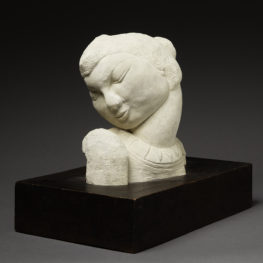Robert Laurent
1890-1970
Best known as a sculptor who worked in a variety of media, Robert Laurent is credited with inaugurating the conscious aesthetic of so-called direct carving technique among American sculptors. Laurent was the son of French peasants in the Breton village of Concarneau, a popular artists’ haunt in the late nineteenth century. In 1901, its international visitors included American art patron, teacher, and editor Hamilton Easter Field (1873-1922), who befriended the eleven-year-old Laurent and brought him and his parents to New York the following year. Field became a surrogate father to Laurent and taught him painting, but Laurent, inspired by African carvings and by the sculptural work of avant-garde European artists, preferred becoming a sculptor. In 1907, he traveled with Field to Rome to learn wood carving. He studied at the British Academy and under Latvian-born American painter Maurice Sterne (1877-1957).
On his return to New York with Field in 1910, Laurent soon joined the circle of artists forging a modern art of abstract forms and bold color and line. He was deeply interested in the examples of cutting-edge art by both European and American artists in the so-called Armory Show of 1913. In 1915 he made his debut in a critically successful two-man exhibition with Field at New York’s Daniel Gallery, in which his wood relief carvings were featured; two years later, he began carving wood sculptures in the round. Upon Field’s death in 1922, Laurent inherited his estate and dedicated himself to continuing Field’s summer art school in coastal Ogunquit, Maine. That year, he received his first solo exhibition, at the Bourgeois Gallery in New York, in which he demonstrated his mastery of direct-carving technique in alabaster and other stones.
In the late 1920s, Laurent expanded his range into working in bronze and he experimented in printmaking. Influenced by the monumental figures sculpted by French sculptor Gaston Lachaise (1882-1935), he began to focus on the nude female form. In the 1930s, his mastery of the figure earned him major commissions for public sculptures for Radio City Music Hall in New York; Fairmount Park, Philadelphia; and the Federal Trade Building in Washington, D.C. In 1938 he won the second of two Logan Prizes at the Art Institute of Chicago’s annual American art exhibition. In addition to teaching seasonally at his Ogunquit School until 1961, Laurent taught at a number of colleges before accepting a post as resident sculptor at Indiana University in 1942, where he remained for nearly two decades. Laurent was elected to the National Institute of Arts and Letters shortly before his death at the age of seventy-nine.
Biography courtesy Terra Foundation

